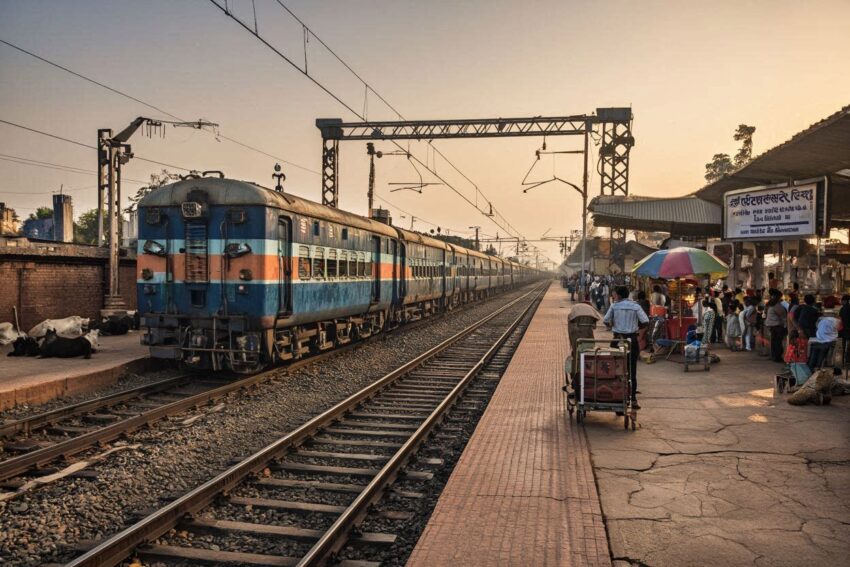India’s Central Railway to Transform Thane Station: Platform Extensions for 15-Coach Locals to Ease Travel by End of 2025
Thane Station in India to extend platforms for 15-coach locals by December 2025, enhancing commuter comfort and reducing congestion on Mumbai’s busy suburban line.
The Central Railway of India has unveiled an ambitious plan to ease the daily struggles of over five lakh commuters who rely on the bustling Thane railway station. By December 2025, the station’s platforms 2, 3, and 4 will be extended to accommodate 15-coach local trains, marking a significant leap toward smoother and safer suburban travel. This initiative, aimed at reducing congestion and improving passenger comfort, reflects the Indian Railways’ growing commitment to modernizing urban mobility infrastructure across Mumbai, one of the busiest metropolitan regions in India.
Currently, Thane station serves as a vital interchange on the Central Line, connecting passengers traveling toward Mumbai, Karjat, and Kasara. With 12-coach trains frequently running at full capacity, overcrowding during peak hours has long been a major challenge. The introduction of longer trains and expanded platforms is expected to transform the daily travel experience, enhancing convenience and ensuring a safer commute for the city’s growing population of suburban rail users.
A Step Toward Seamless Travel for Thanekars
The platform extension project at Thane station has been initiated as part of Central Railway’s ongoing modernization efforts. Once completed, the extended platforms will enable the operation of 15-coach local trains, replacing the existing 12-coach services that often leave commuters struggling for space.
According to officials, Platform 2 will be widened by 16.15 metres, while Platforms 3 and 4 will each be extended by up to 40 metres. This enhancement will allow for increased passenger dispersal and improved boarding and alighting efficiency. The design is being executed with a focus on commuter safety, crowd management, and accessibility.
The move comes after years of appeals from passenger associations and local residents who have faced overcrowding challenges at Thane, one of the busiest railway stations in India. The project represents a major infrastructural upgrade that aligns with Central Railway’s goal of improving travel efficiency on the Mumbai suburban network.
Addressing Overcrowding and Commuter Strain
Every day, an estimated five lakh passengers pass through Thane station, making it one of the most crowded hubs on the Mumbai suburban network. During rush hours, passengers frequently struggle to board trains, often letting several pass before managing to find space. The introduction of 15-coach trains is expected to significantly reduce this burden.
Once operational, the longer trains will not only increase seating and standing capacity but also streamline passenger flow on and off platforms. The station’s expansion will contribute to shorter waiting times, less congestion, and a more comfortable travel experience. These improvements are expected to particularly benefit office-goers, students, and daily travelers between Mumbai, Thane, and the neighboring regions of Karjat and Kasara.
The broader aim is to ensure that Thane station remains equipped to meet rising commuter demand as Mumbai’s suburban rail network continues to expand.
Previous Improvements Set the Foundation
The upcoming platform extensions build upon earlier infrastructural improvements. In May 2024, Platform 5 at Thane station was widened from 10 metres to 13 metres, using modular construction techniques. This prior enhancement successfully improved passenger handling capacity and demonstrated the effectiveness of modern engineering solutions in crowded railway environments.
These earlier upgrades were part of a broader modernization plan initiated by Central Railway, targeting critical suburban junctions that experience high footfall. The success of the 2024 project laid the groundwork for more ambitious developments, including the ongoing plan to extend multiple platforms simultaneously without disrupting daily operations.
Improving Connectivity Beyond Thane
While the Central Line sees major upgrades, similar efforts are being mirrored across India’s Western Railway network. Passenger associations have called for the introduction of 15-coach locals between Virar and Dahanu, another heavily trafficked stretch. Railway authorities have acknowledged the demand and stated that while the section is nearing capacity, ongoing work to quadruple the 63-kilometre track between Virar and Dahanu will soon allow for increased train operations.
This initiative reflects the broader vision of Indian Railways to enhance connectivity and commuter convenience across the Mumbai Metropolitan Region. With thousands of new passengers joining the suburban network every year, these expansion projects are crucial for ensuring long-term sustainability and passenger safety.
A Travel and Tourism Perspective
The suburban train system forms the backbone of daily life in Mumbai, connecting millions of people to workplaces, educational institutions, and tourist destinations across the city. For travelers visiting India, particularly Mumbai, the suburban rail experience is both practical and cultural—offering a glimpse into the rhythm of everyday urban life.
With Thane station’s upcoming transformation, tourists and domestic travelers will benefit from improved accessibility to Thane’s growing attractions, from its historical landmarks to scenic spots like Upvan Lake and Yeoor Hills. The expansion will also enhance connectivity between Mumbai and nearby regions, supporting the city’s role as a gateway for travelers exploring western India.
As infrastructure modernizes, India’s suburban railways are increasingly being recognized as models of efficient mass transit, combining traditional systems with modern design to cater to millions.
Economic and Social Impact
Beyond its travel benefits, the project is expected to bring economic and social advantages to Thane and its surrounding districts. With faster and more comfortable train services, productivity is likely to increase as commute times stabilize. Businesses around the station, including retail outlets and food vendors, are also expected to benefit from improved passenger circulation.
Moreover, the project supports India’s broader goals of sustainable urban transport by encouraging rail travel over road congestion. Longer trains translate to fewer vehicles on the road, contributing to reduced emissions and promoting environmentally friendly commuting options.
Looking Ahead: Toward a Smarter Suburban Network
The Central Railway’s Thane station project symbolizes the gradual transformation of India’s railway ecosystem into a smarter, more passenger-focused system. By the end of 2025, once the extensions are complete, Thane will join a growing list of suburban stations designed to accommodate future-ready, high-capacity trains.
As Mumbai’s urban footprint expands, such forward-thinking infrastructural upgrades will be vital to sustaining efficient mobility for both residents and visitors. The integration of technology, safety, and comfort in the design of Thane’s extended platforms represents a step toward a more resilient and traveler-friendly Indian Railways network.
In essence, this initiative not only enhances the daily commute for Thanekars but also strengthens India’s position as a country actively investing in modern, sustainable, and commuter-centric transportation solutions.
The post India’s Central Railway to Transform Thane Station: Platform Extensions for 15-Coach Locals to Ease Travel by End of 2025 appeared first on Travel and Tour World


